Themed collection New Perspectives on Molecular Simulation of Chemistry and Physics in External Electric Fields

New perspectives on molecular simulation of chemistry and physics in external electric fields
This themed collection includes a collection of articles on molecular simulation of chemistry and physics in external electric fields.

Phys. Chem. Chem. Phys., 2022,24, 28660-28661
https://doi.org/10.1039/D2CP90209E
Electromagnetic bioeffects: a multiscale molecular simulation perspective
We summarise methodologies, challenges and opportunities for theoretical modelling to advance current understanding of electromagnetic bioeffects for biomedicine and industry.
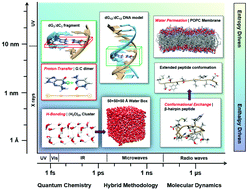
Phys. Chem. Chem. Phys., 2022,24, 6327-6348
https://doi.org/10.1039/D1CP05510K
Multi-resolution simulation of DNA transport through large synthetic nanostructures
A new combination of coarse-grained modeling and finite element calculations enable rapid and accurate characterization of DNA transport through nanostructures of diverse geometries.
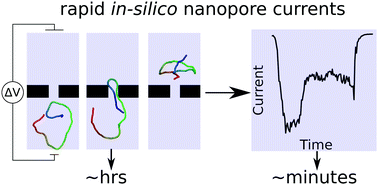
Phys. Chem. Chem. Phys., 2022,24, 2706-2716
https://doi.org/10.1039/D1CP04589J
Electropumping of nanofluidic water by linear and angular momentum coupling: theoretical foundations and molecular dynamics simulations
Water confined by asymmetric hydrophobic/hydrophilic walls (left) and symmetric hydrophilic walls (right), and associated streaming velocity profiles in the steady-state after application of a rotating electric field.

Phys. Chem. Chem. Phys., 2021,23, 25003-25018
https://doi.org/10.1039/D1CP04139H
A rationale for non-linear responses to strong electric fields in molecular dynamics simulations
Many approaches for calculation of the field-dependent electric properties of water solutions rely on the Onsager and Kirkwood theories of polar dielectrics.
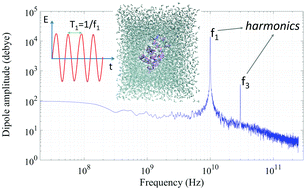
Phys. Chem. Chem. Phys., 2022,24, 11654-11661
https://doi.org/10.1039/D1CP04466D
Brownian dynamics of cylindrical capsule-like particles in a nanopore in an electrically biased solid-state membrane
Charged particles traversing an electrically biased nanopore tend to rotate the least where a larger net charge or particle length results in a smaller range of rotational movement and strongly affects the particle's translocation time.
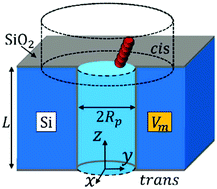
Phys. Chem. Chem. Phys., 2022,24, 2958-2965
https://doi.org/10.1039/D1CP03965B
Can the local electric field be a descriptor of catalytic activity? A case study on chorismate mutase
The local electric field (LEF) of the enzyme along the reaction axis can be an efficient descriptor for the enzymatic activity.

Phys. Chem. Chem. Phys., 2022,24, 1974-1981
https://doi.org/10.1039/D1CP03978D
Dielectric properties of ice VII under the influence of time-alternating external electric fields
The high-pressure solid phase of water known as ice VII has recently attracted a lot of attention when its presence was detected in large exoplanets, their icy satellites, and even in Earth's mantle.

Phys. Chem. Chem. Phys., 2022,24, 56-62
https://doi.org/10.1039/D1CP04165G
Reversible electrowetting transitions on superhydrophobic surfaces
The transition from the Cassie to the Wenzel state of an electrowetted surface strongly depends on the polarity of the electric field.

Phys. Chem. Chem. Phys., 2021,23, 27005-27013
https://doi.org/10.1039/D1CP04220C
Molecular dissociation and proton transfer in aqueous methane solution under an electric field
Here we present a study relying upon state-of-the-art ab initio molecular dynamics simulations where a liquid aqueous methane solution is exposed to strong oriented static and homogeneous electric fields.
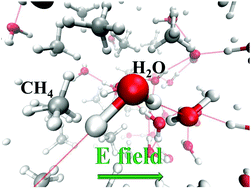
Phys. Chem. Chem. Phys., 2021,23, 25649-25657
https://doi.org/10.1039/D1CP04202E
Electrostatic effects in N-heterocyclic carbene catalysis: revealing the nature of catalysed decarboxylation
Quantum-chemical calculations show that protonated N-heterocyclic carbenes catalyse decarboxylation via electrostatic effects.

Phys. Chem. Chem. Phys., 2021,23, 24627-24633
https://doi.org/10.1039/D1CP04444C
Electric fields and potentials in condensed phases
Electric potential isosurfaces and field lines inside a CuII-SSZ-13 zeolite catalyst.

Phys. Chem. Chem. Phys., 2021,23, 23836-23849
https://doi.org/10.1039/D1CP03571A
About this collection
The timely topic of external electric fields in molecular simulation, with a focus on the emergent theme of handling chemical reactions is expected to stimulate discussion and offer insights into external field manipulation of chemical reactions, including experimental studies into microscopic fundamentals. This exciting area of physical chemistry builds on the foundations laid at the 2011 CECAM workshop and the aim of this themed collection is to bring together the progress made in this fast-moving field over the past 10 years, to provide an invaluable resource to anyone working in this area.
Guest Edited by: Niall English (University College Dublin), Maria Gracheva (Clarkson University), Peter Kusalik (University of Calgary) and Sason Shaik (Hebrew University of Jerusalem).
Also of relevance:
Effects of Electric Fields on Structure and Reactivity: New Horizons in Chemistry
Edited by Sason Shaik and Thijs Stuyver
Written by leaders in the field, Effects of Electric Fields on Structure and Reactivity is the first book on this exciting topic. Starting with an overview of the theory behind the effect of electric fields on chemical structure and reactivity, this accessible reference work aims to encourage those new to the field to consider harnessing these effects in their own work. Covering applications and recent theoretical developments, it is a useful resource for theoretical chemists and experimentalists alike.